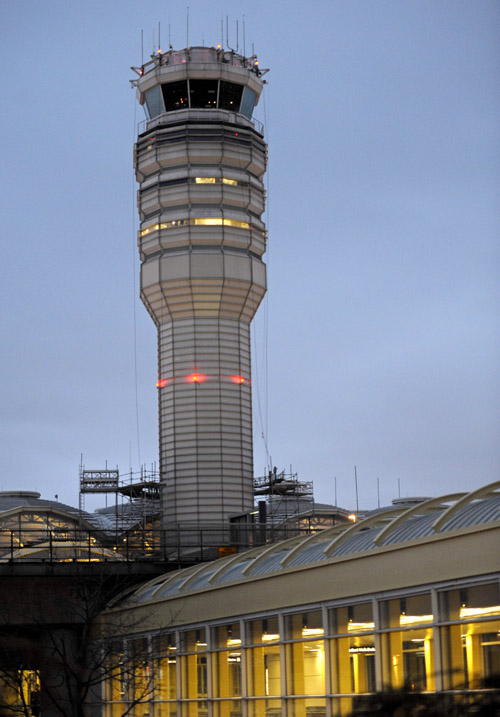WASHINGTON — Authorities have suspended a control tower supervisor working alone overnight who couldn’t be roused to guide two airliners landing at Washington’s Reagan airport, the nation’s top aviation official said today.
“As a former airline pilot, I am personally outraged that this controller did not meet his responsibility to help land these two airplanes,” Federal Aviation Administration Administrator Randy Babbitt said.
An aviation official who spoke on condition of anonymity because an investigation is underway said the supervisor — the lone air traffic controller on duty at the airport around midnight Tuesday — fell asleep.
“I am determined to get to the bottom of this situation for the safety of the traveling public,” Babbitt said.
The supervisor, who wasn’t named, has been suspended from operational duties pending an investigation, Babbitt said.
On Wednesday, Transportation Secretary Ray LaHood LaHood directed the FAA to launch a nationwide study of airport tower staffing. He also directed that at least two controllers be on duty at night at Reagan, which is located just across the Potomac River from Washington in Northern Virginia.
“It is not acceptable to have just one controller in the tower managing air traffic in this critical air space,” LaHood said.
The head of the union that represents air traffic controllers praised LaHood’s actions, saying changes in staffing are needed.
“One-person shifts are unsafe. Period,” Paul Rinaldi, president of the National Air Traffic Controllers Association, said in a statement today. He said the union has long been concerned about single controller shifts, citing a 2006 air crash in Lexington, Ky., in which a Comair regional airliner attempted a takeoff at night from the wrong runway. A single air traffic controller was on duty in the airport tower at the time.
“The administration inherited an unsafe policy of staffing to budget instead of putting safety first,” Rinaldi said. “We fully support the administration’s aggressive actions to change this policy.”
In this week’s incident, the pilots of the two planes — American Airlines flight 1012, a Boeing 737 with 91 passengers and 6 crew members on board, and United Airlines flight 628T, an Airbus A320 with 63 passengers and five crew members — were unable to raise a controller at Reagan as they approached the airport.
They were, however, in contact with controllers at a regional FAA facility about 40 miles away in Warrenton, Va. Those controllers tried repeatedly to contact the tower by phone, but their calls went unanswered, said National Transportation Safety Board spokesman Peter Knudson.
The board is also reviewing the incident in order to decide whether to open a full-fledged investigation, he said.
For many years, air traffic at Reagan was severely restricted between 10 p.m. and 7 a.m. to limit noise in surrounding communities, noted Bill Voss, president of the Flight Safety Foundation, an industry-funded group that promotes aviation safety. Today there is more air traffic at night because jets are quieter, but there are still so few landings after midnight that it may be reasonable to have only one controller on duty, he said.
“It’s not outrageous for the agency to avoid putting a second six-figure employee into a tower where they may only work a dozen airplanes in a shift,” said Voss, a former air traffic controller.
Regional air traffic facilities handle aircraft within roughly a 50-mile radius of an airport, but landings, takeoffs and planes within about three miles of an airport are handled by controllers in the airport tower.
There was probably little safety risk in Washington since the pilots would have used a radio frequency for the airport tower to advise nearby aircraft of their intention to land and to make sure that no other planes also intended to land at that time, aviation safety experts said. At that time of night, air traffic would have been light, they said.
Also, controllers at the regional facility, using radar, would have been able to advise the pilots of other nearby planes, experts said.
The primary risk would have been if there was equipment on the runway when the planes landed, they said.
But the incident raises serious questions about controller fatigue, a longstanding safety concern, said John Goglia, a former NTSB board member.
Goglia said shifts must be scheduled to ensure controllers can get enough rest.
“It’s worse when nothing is going on,” he said. “When it’s busy, you have to stay engaged. When it’s quiet, all they have to be is a little bit tired and they’ll fall asleep.”
Send questions/comments to the editors.




Success. Please wait for the page to reload. If the page does not reload within 5 seconds, please refresh the page.
Enter your email and password to access comments.
Hi, to comment on stories you must . This profile is in addition to your subscription and website login.
Already have a commenting profile? .
Invalid username/password.
Please check your email to confirm and complete your registration.
Only subscribers are eligible to post comments. Please subscribe or login first for digital access. Here’s why.
Use the form below to reset your password. When you've submitted your account email, we will send an email with a reset code.